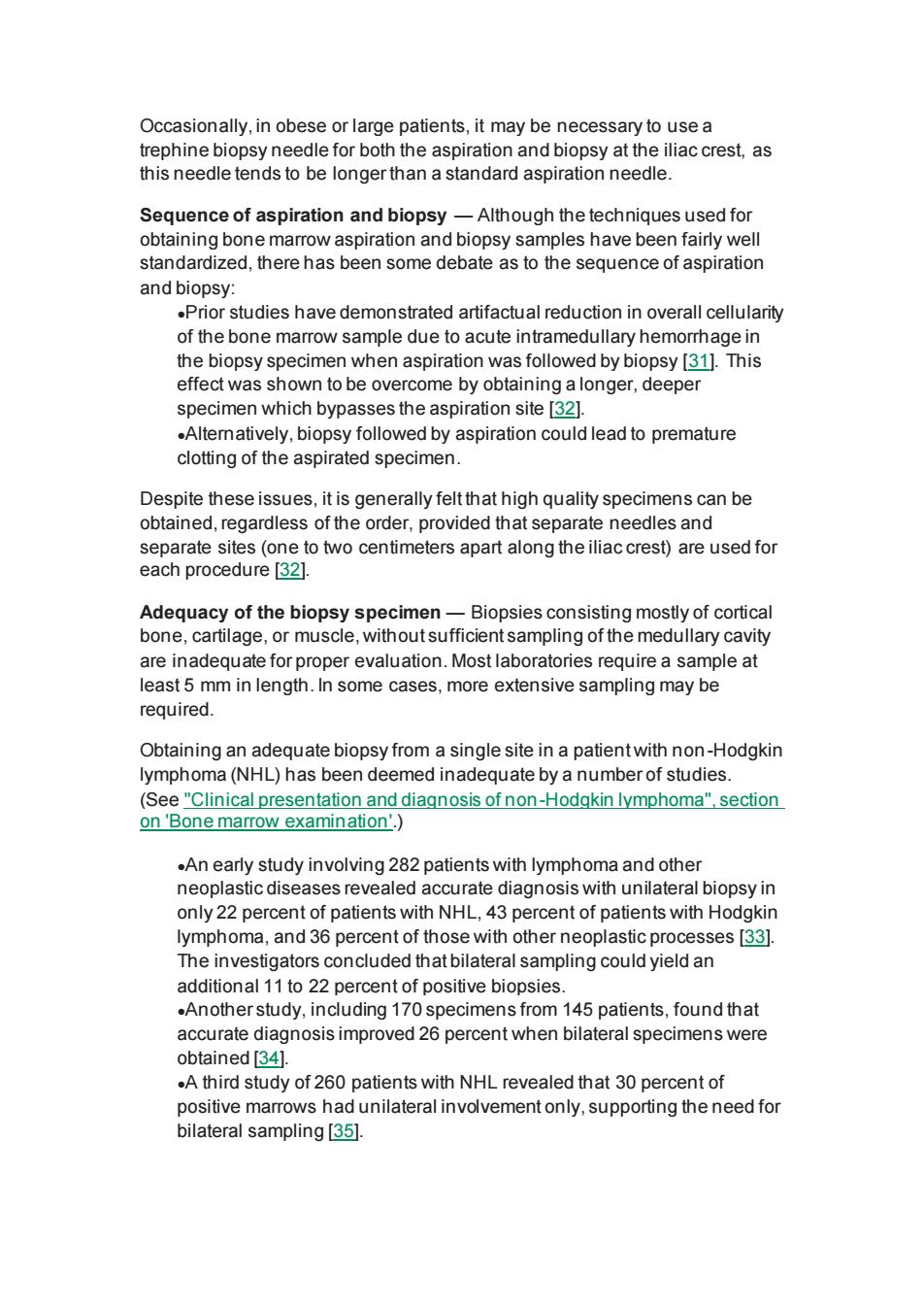正在加载图片...

Occasionally,in obese or large patients,it may be necessary to use a Sequence of aspiration and biops -Althouah the techniques used fo obtaining bon e marrow aspiration and biopsy samples have be nfairly we standardized.there has been some debate as to the sequence of aspiration and biopsy: .Prior studies have demonstrated artifactual reduction in overall cellularity of the bone marrow sample due to acute intramedullary hemorrhage in th when aspiration was foll eRways6moeoenetyo wed by bi psy [31].This ning a longer,deeper specimen which bypasses the aspiration site [32]. .Altemnatively,biopsy followed by aspiration could lead to premature clotting of the aspirated specimen. Despite these issues,it is generally felt that high quality specimens can be obtained,regardless of the order,provided that separate needles and 8ap8ce0e8owocentmeesapanaongheiaces0aeusedio Adequacy of the biopsy specimen-Biopsies consisting mostly of cortical bone.cartilage,or muscle,v are least 5 mm in length.In some cases,more extensive sampling may be required. Obtaining an adequate biopsy from a single site in a patientwith non-Hodgkin ymphoma(NHL)has been deemed inadequate by a number of studies. (See"Clinical presentation and diagnosis of non-Hodgkin lymphoma",section on Bone marrow examination'.) .An early study involving 282 patients with lymphoma and other neoplastic diseases revealed accurate diagnosis with unilateral biopsy in only 22 percent of patients with NHL,43 percent of patients with Hodgkin ympho and 36 pe t of th ewith other neoplastic sses [33]. The investigators concluded that bilateral sampling could yield ar additional 11 to 22 percent of positive biopsies. .Another study,including 170 specimens from 145 patients,found that accurate diagnosis improved 26 percent when bilateral specimens were obtained [341 A third study of 260 patients with NHL revealed that 30 percent of positive marrows had unilateral involvement only,supporting the need for bilateral sampling [35].Occasionally, in obese or large patients, it may be necessary to use a trephine biopsy needle for both the aspiration and biopsy at the iliac crest, as this needle tends to be longer than a standard aspiration needle. Sequence of aspiration and biopsy — Although the techniques used for obtaining bone marrow aspiration and biopsy samples have been fairly well standardized, there has been some debate as to the sequence of aspiration and biopsy: ●Prior studies have demonstrated artifactual reduction in overall cellularity of the bone marrow sample due to acute intramedullary hemorrhage in the biopsy specimen when aspiration was followed by biopsy [31]. This effect was shown to be overcome by obtaining a longer, deeper specimen which bypasses the aspiration site [32]. ●Alternatively, biopsy followed by aspiration could lead to premature clotting of the aspirated specimen. Despite these issues, it is generally felt that high quality specimens can be obtained, regardless of the order, provided that separate needles and separate sites (one to two centimeters apart along the iliac crest) are used for each procedure [32]. Adequacy of the biopsy specimen — Biopsies consisting mostly of cortical bone, cartilage, or muscle, without sufficient sampling of the medullary cavity are inadequate for proper evaluation. Most laboratories require a sample at least 5 mm in length. In some cases, more extensive sampling may be required. Obtaining an adequate biopsy from a single site in a patient with non -Hodgkin lymphoma (NHL) has been deemed inadequate by a number of studies. (See "Clinical presentation and diagnosis of non-Hodgkin lymphoma", section on 'Bone marrow examination'.) ●An early study involving 282 patients with lymphoma and other neoplastic diseases revealed accurate diagnosis with unilateral biopsy in only 22 percent of patients with NHL, 43 percent of patients with Hodgkin lymphoma, and 36 percent of those with other neoplastic processes [33]. The investigators concluded that bilateral sampling could yield an additional 11 to 22 percent of positive biopsies. ●Another study, including 170 specimens from 145 patients, found that accurate diagnosis improved 26 percent when bilateral specimens were obtained [34]. ●A third study of 260 patients with NHL revealed that 30 percent of positive marrows had unilateral involvement only, supporting the need for bilateral sampling [35]